stop start MITSUBISHI OUTLANDER 2018 (in English) Owner's Guide
[x] Cancel search | Manufacturer: MITSUBISHI, Model Year: 2018, Model line: OUTLANDER, Model: MITSUBISHI OUTLANDER 2018Pages: 441, PDF Size: 13.71 MB
Page 334 of 441
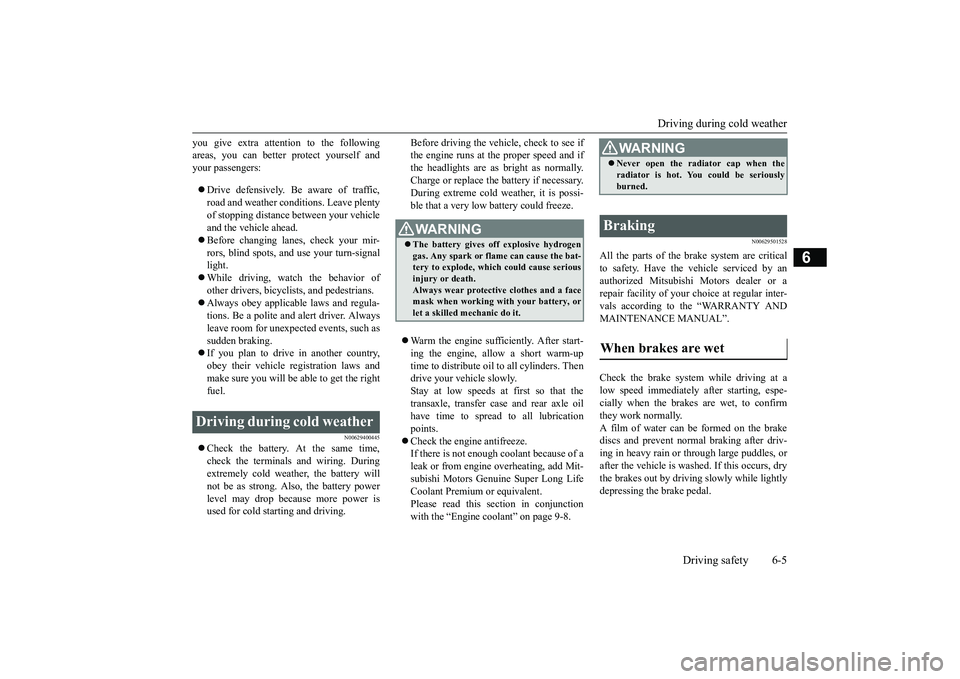
Driving during cold weather
Driving safety 6-5
6
you give extra attention to the followingareas, you can better protect yourself andyour passengers:Drive defensively. Be aware of traffic,road and weather c
onditions. Leave plenty
of stopping distance
between your vehicle
and the vehicle ahead.Before changing lanes, check your mir-rors, blind spots, a
nd use your turn-signal
light.While driving, watch the behavior ofother drivers, bicycl
ists, and pedestrians.
Always obey applicab
le laws and regula-
tions. Be a polite and alert driver. Alwaysleave room for unexpected events, such assudden braking.If you plan to drive in another country,obey their vehicle re
gistration laws and
make sure you will be able to get the rightfuel.
N00629400445
Check the battery. At the same time,check the terminals and wiring. Duringextremely cold weather, the battery willnot be as strong. Also, the battery powerlevel may drop beca
use more power is
used for cold starting and driving.
Before driving the vehicle, check to see ifthe engine runs at the proper speed and ifthe headlights are as bright as normally.Charge or replace the battery if necessary.During extreme cold weather, it is possi-ble that a very low battery could freeze.Warm the engine sufficiently. After start-ing the engine, allow a short warm-uptime to distribute oil to all cylinders. Thendrive your vehicle slowly.Stay at low speeds at first so that thetransaxle, transfer case and rear axle oilhave time to spread to all lubricationpoints.Check the engine antifreeze.If there is not enough coolant because of aleak or from engine
overheating, add Mit-
subishi Motors Genuine Super Long LifeCoolant Premium or equivalent.Please read this section in conjunctionwith the “Engine coolant” on page 9-8.
N00629501528
All the parts of the brake system are criticalto safety. Have the
vehicle serviced by an
authorized Mitsubishi Motors dealer or arepair facility of your
choice at regular inter-
vals according to the “WARRANTY ANDMAINTENANCE MANUAL”.Check the brake system while driving at alow speed immediately
after starting, espe-
cially when the brakes are wet, to confirmthey work normally.A film of water can be formed on the brakediscs and prevent normal braking after driv-ing in heavy rain or through large puddles, orafter the vehicle is washed. If this occurs, drythe brakes out by drivi
ng slowly while lightly
depressing the brake pedal.
Driving during cold weather
WA R N I N GThe battery gives off explosive hydrogengas. Any spark or flame can cause the bat-tery to explode, which could cause seriousinjury or death.Always wear protecti
ve clothes and a face
mask when working with your battery, orlet a skilled mechanic do it.
WA R N I N GNever open the radiator cap when theradiator is hot. You could be seriouslyburned.
Braking When brakes are wet
BK0249100US.book 5 ページ 2017年5月10日 水曜日 午前8時49分
Page 344 of 441

Trailer towing
Driving safety 6-15
6
You’ll need more passing distance up aheadwhen you’re towing a trailer. And, becauseyou’re a good deal longer, you’ll need to gomuch farther beyond the passed vehiclebefore you can return to your lane.Hold the bottom of the steering wheel withone hand. Then, to move the trailer to the left,just move that hand to the left. To move thetrailer to the right, move your hand to theright. Always back up sl
owly and, if possible,
have someone guide you.When you’re turning with a trailer, makewider than normal turns to help prevent thetrailer from striking shoulders, curbs, roadsigns, trees or other objects.
Avoid jerky or sudden maneuvers. Signalwell in advance.Towing a trailer puts additional burden on theengine and transaxle,
which may cause over-
heating. Following ar
e some suggestions to
reduce overheating:When towing at high al
titudes, engine coolant
and automatic transaxle oil will overheat at alower temperature than at normal altitudes.If you turn your engine off immediately aftertowing at high altitude
on steep uphill grades,
your vehicle may show
signs similar to over-
heating. To avoid this
, let the engine run
while parked (preferably on level ground)with the automatic transaxle in the “P”turning the engine off.
If the engine coolant temperature indica-tor flashes on the information screen inthe multi-information display or theengine power drops suddenly, refer to“Engine overheati
ng” on page 8-4.
If the warning display or warningdisplay illuminates, re
fer to “Warning dis-
play” on page 5-70, 5-78.
Reduce speed and downshift before you startdown a long or steep downgrade. If you don’tdownshift, over using the brakes can causereduced brake efficiency.You can tow in “D” (DRIVE) position. Youmay want to shift the selector lever to the 3rdor a lower position, under heavy loads or hillyconditions.Always place chocks or blocks under both thevehicle and trailer wheels when parking. Besure that the parking brake is firmly set andthat the selector lever is in the “P” (PARK)position. Avoid parki
ng on a hill with a
trailer, but if it cannot be avoided, do so onlyafter performing the following:
Passing Backing up Making turns
CAUTIONMaking sharp turns while towing a trailercould cause the
trailer to come in contact
with the vehicle. Your
vehicle could be dam-
aged. Avoid making sharp turns while tow-ing a trailer.
Overheating Cause of overheating
Solution
Air conditioning on Turn offHighway speeds Reduce speedGoing up hills Select lower gear posi-
tion
Stop-and-go city traf-fic
With the vehicle stopped, shift to the “N” (NEUTRAL) position and idle the engine at high idle.
Driving on hills Parking
BK0249100US.book 15 ページ 2017年5月10日 水曜日 午前8時49分
Page 363 of 441
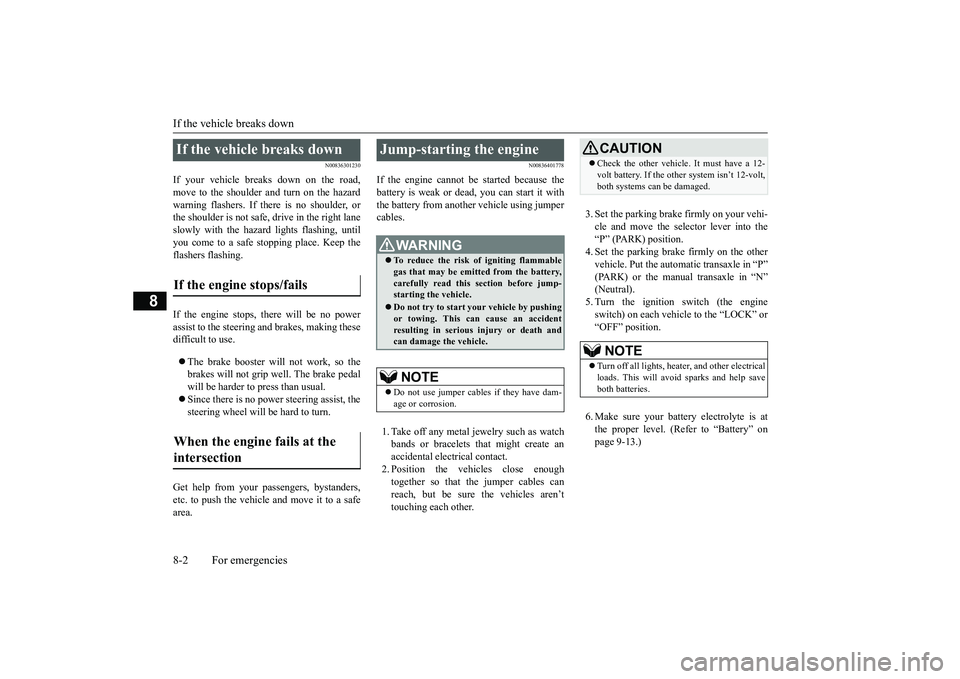
If the vehicle breaks down8-2 For emergencies
8
N00836301230
If your vehicle breaks down on the road,move to the shoulder and turn on the hazardwarning flashers. If there is no shoulder, orthe shoulder is not safe, drive in the right laneslowly with the hazard
lights flashing, until
you come to a safe stopping place. Keep theflashers flashing.If the engine stops, there will be no powerassist to the steering and brakes, making thesedifficult to use.The brake booster will not work, so thebrakes will not grip well. The brake pedalwill be harder to press than usual.Since there is no power steering assist, thesteering wheel will be hard to turn.
Get help from your passengers, bystanders,etc. to push the vehicle
and move it to a safe
area.
N00836401778
If the engine cannot be started because thebattery is weak or de
ad, you can start it with
the battery from anothe
r vehicle using jumper
cables.1. Take off any metal jewelry such as watchbands or bracelets th
at might create an
accidental electrical contact.2. Position the vehi
cles close enough
together so that the jumper cables canreach, but be sure the vehicles aren’ttouching each other.
3. Set the parking brake firmly on your vehi-cle and move the selector lever into the“P” (PARK) position.4. Set the parking brake firmly on the othervehicle. Put the automatic transaxle in “P”5. Turn the ignition switch (the engineswitch) on each vehicle to the “LOCK” or“OFF” position.6. Make sure your battery electrolyte is atthe proper level. (Refer to “Battery” onpage 9-13.)
If the vehicle breaks down If the engine stops/fails When the engine fails at the intersection
Jump-starting the engine
WA R N I N GTo reduce the risk of igniting flammablegas that may be emitted from the battery,carefully read this section before jump-starting the vehicle.Do not try to start you
r vehicle by pushing
or towing. This can cause an accidentresulting in serious
injury or death and
can damage the vehicle.NOTE
Do not use jumper cables if they have dam-age or corrosion.
CAUTIONCheck the other vehicle.
It must have a 12-
volt battery. If the other system isn’t 12-volt,both systems can be damaged.NOTE
Turn off all lights, heat
er, and othe
r electrical
loads. This will avoid sparks and help saveboth batteries.
BK0249100US.book 2 ページ 2017年5月10日 水曜日 午前8時49分
Page 365 of 441
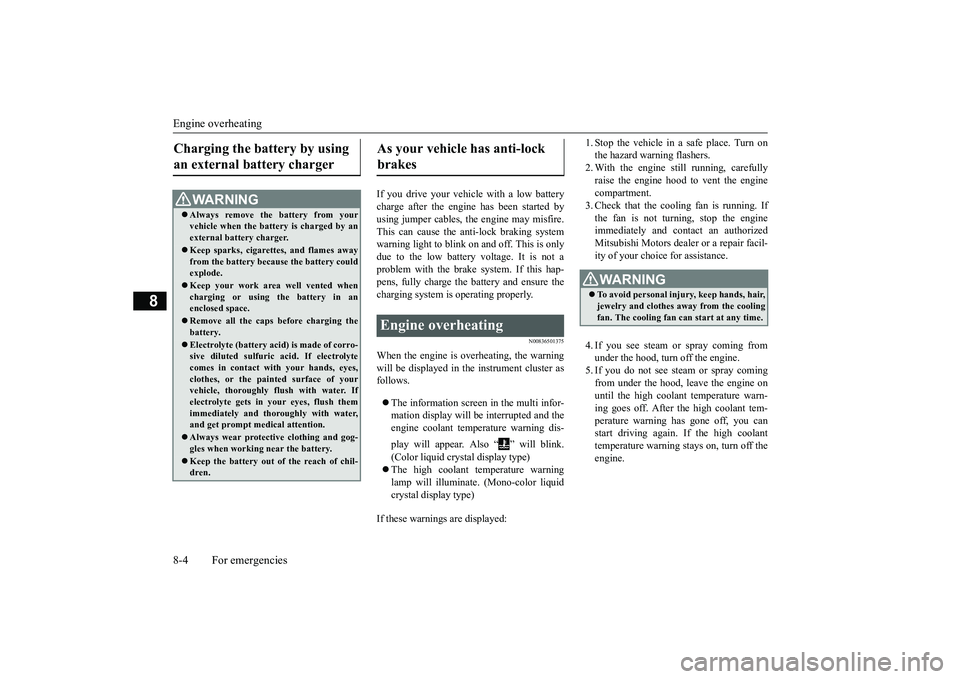
Engine overheating8-4 For emergencies
8
If you drive your vehicl
e with a low battery
charge after the engine has been started byusing jumper cables, th
e engine may misfire.
This can cause the anti-lock braking systemwarning light to blink on
and off. This is only
due to the low battery voltage. It is not aproblem with the brake system. If this hap-pens, fully charge the battery and ensure thecharging system is operating properly.
N00836501375
When the engine is overheating, the warningwill be displayed in th
e instrument cluster as
follows.The information screen in the multi infor-mation display will be interrupted and theengine coolant temp
erature warning dis-
play will appear. Also “ ” will blink.(Color liquid crystal display type)lamp will illuminate.
(Mono-color liquid
crystal display type)
If these warnings are displayed:
1. Stop the vehicle in a safe place. Turn onthe hazard warning flashers.2. With the engine st
ill running, carefully
raise the engine hood to vent the enginecompartment.3. Check that the cooling fan is running. Ifthe fan is not turn
ing, stop the engine
immediately and cont
act an authorized
Mitsubishi Motors dealer or a repair facil-ity of your choice for assistance.4. If you see steam or spray coming fromunder the hood, turn off the engine.5. If you do not see steam or spray comingfrom under the hood, leave the engine onuntil the high coolant
temperature warn-
ing goes off. After the high coolant tem-perature warning has gone off, you canstart driving again. If the high coolanttemperature warning stays on, turn off theengine.
Charging the battery by using an external battery charger
WA R N I N GAlways remove the
battery from your
vehicle when the battery is charged by anexternal battery charger.Keep sparks, cigarette
s, and flames away
from the battery because the battery couldexplode.Keep your work area well vented whencharging or using
the battery in an
enclosed space.Remove all the caps before charging thebattery.Electrolyte (battery acid) is made of corro-sive diluted sulfuric acid. If electrolytecomes in contact with your hands, eyes,clothes, or the pain
ted surface of your
vehicle, thoroughly
flush with water. If
electrolyte gets in your eyes, flush themimmediately and thor
oughly with water,
and get prompt medical attention.Always wear protective clothing and gog-gles when working near the battery.Keep the battery out of the reach of chil-dren.
As your vehicle has anti-lock brakes Engine overheating
WA R N I N GTo avoid personal injury, keep hands, hair,jewelry and clothes aw
ay from the cooling
fan. The cooling fan ca
n start at any time.
BK0249100US.book 4 ページ 2017年5月10日 水曜日 午前8時49分
Page 370 of 441
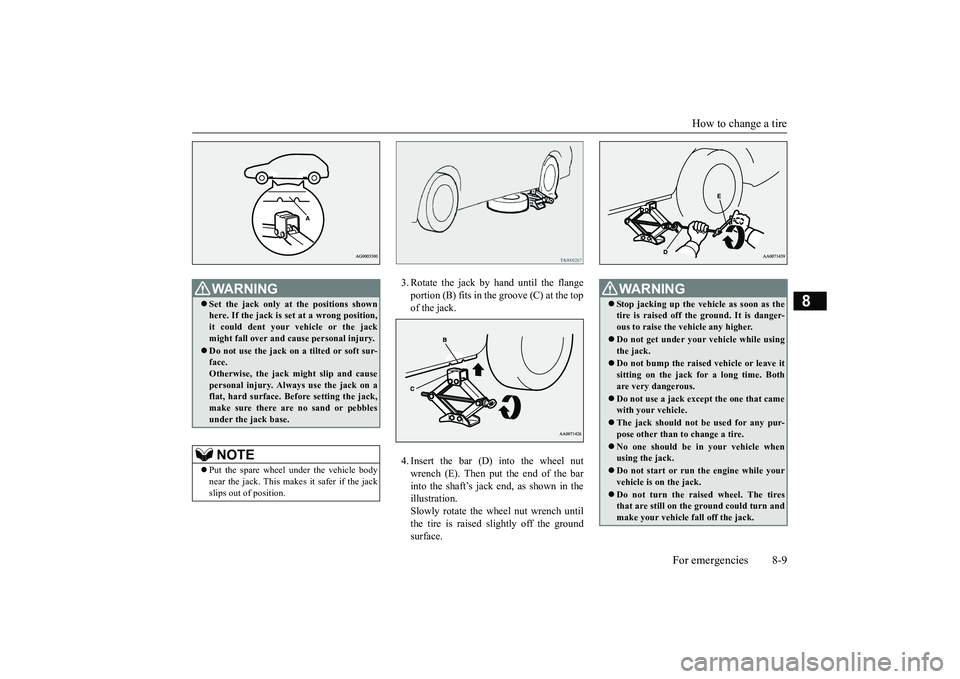
How to change a tire
For emergencies 8-9
8
3. Rotate the jack by hand until the flangeportion (B) fits in the groove (C) at the topof the jack.4. Insert the bar (D) into the wheel nutwrench (E). Then put the end of the barinto the shaft’s jack end, as shown in theillustration.Slowly rotate the wheel nut wrench untilthe tire is raised slightly off the groundsurface.
WA R N I N GSet the jack only at
the positions shown
here. If the jack is se
t at a wrong position,
it could dent your vehicle or the jackmight fall over and ca
use personal injury.
Do not use the jack on a tilted or soft sur-face.Otherwise, the jack might slip and causepersonal injury. Always
use the jack on a
flat, hard surface. Before setting the jack,make sure there are no sand or pebblesunder the jack base.NOTE
Put the spare wheel under the vehicle bodynear the jack. This makes it safer if the jackslips out of position.
WA R N I N GStop jacking up the ve
hicle as soon as the
tire is raised off the ground. It is danger-ous to raise the ve
hicle any higher.
Do not get under your vehicle while usingthe jack.Do not bump the raised
vehicle or leave it
sitting on the jack for a long time. Bothare very dangerous.Do not use a jack except the one that camewith your vehicle.The jack should not
be used for any pur-
pose other than to change a tire.No one should be
in your vehicle when
using the jack.Do not start or run
the engine while your
vehicle is on the jack.Do not turn the raised wheel. The tiresthat are still on the ground could turn andmake your vehicle fall off the jack.
BK0249100US.book 9 ページ 2017年5月10日 水曜日 午前8時49分
Page 377 of 441

Fuel Pump Shut-off System8-16 For emergencies
8
When driving on a road covered withsnow or ice, use s
now tires. Tire chains
cannot be used on your vehicle. Theremay be state or local regulations aboutusing snow tires. Al
ways check the regu-
lations in your local area before usingthem. Refer to “Snow tires” on page 9-21and “Tire chains” on page 9-22.Drive slowly. Do not make sudden startsor stops, sharp turns, or slam on thebrakes.Allow extra distance
between your vehi-
cle and the vehicle in front of you, andavoid sudden braking.If a skid occurs when the acceleratorpedal is depressed, take your foot off thepedal. Steer gently in the direction of theskid.Your vehicle is equipped with an anti-lockbraking system (ABS). Hold the brakepedal down firmly and keep it depressed.Do not pump the brake pedal which willresult in reduced braking performance.After parking on snowy or icy roads, itmay be difficult to move your vehicle dueto the brake being frozen. Depress theaccelerator pedal little by little to movethe vehicle when safe to do so.
Drive as slow as pos
sible when driving on
bumpy, rutted roads or over potholes.
N00860600031
In the event of a collision causing frontal air-bag deployment, the fuel pump shut-off sys-tem will activate to st
op fuel supply to the
engine.
On snowy or icy roads
CAUTIONDo not depress the acce
lerator pedal rapidly.
The vehicle could start moving when itbreaks free from the
ice, possibly resulting in
an accident.
On a bumpy or rutted road
CAUTIONDriving on bumpy, rutted roads or over pot-holes can damage th
e tires and wheels.
Wheels with low-profiles tires or under-inflated tires are especially at risk for dam-age.
Fuel Pump Shut-off System
WA R N I N GBefore attempting to restart the engineafter a collision, alw
ays inspect the ground
under the vehicle for leaking fuel. If a fuelleak is found or a fuel
odor is detected, do
not restart the engine.Mitsubishi Motors recommends that yourvehicle be inspected by
an author
ized Mit-
subishi Motors dealer
after any collision.
BK0249100US.book 16 ページ 2017年5月10日 水曜日 午前8時49分
Page 380 of 441
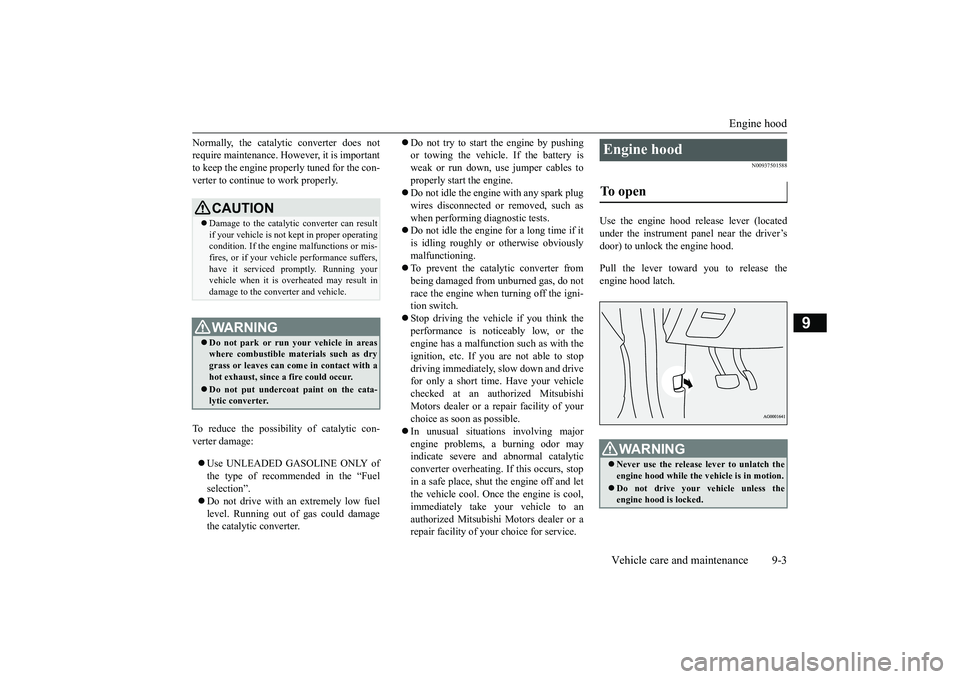
Engine hood
Vehicle care and maintenance 9-3
9
Normally, the catalyti
c converter does not
require maintenance. However, it is importantto keep the engine properly tuned for the con-verter to continue to work properly.To reduce the possibili
ty of catalytic con-
verter damage:Use UNLEADED GASOLINE ONLY ofthe type of recommended in the “Fuelselection”.Do not drive with an extremely low fuellevel. Running out of gas could damagethe catalytic converter.
Do not try to start the engine by pushingor towing the vehicle. If the battery isweak or run down, use jumper cables toproperly start the engine.Do not idle the engine with any spark plugwires disconnected or removed, such aswhen performing
diagnosti
c tests.
Do not idle the engine
for a long time if it
is idling roughly or otherwise obviouslymalfunctioning.To prevent the catalytic converter frombeing damaged from unburned gas, do notrace the engine when turning off the igni-tion switch.Stop driving the vehicle if you think theperformance is noticeably low, or theengine has a malfunction such as with theignition, etc. If you are not able to stopdriving immediately,
slow down and drive
for only a short time. Have your vehiclechecked at an authorized MitsubishiMotors dealer or a repair facility of yourchoice as soon
as possible.
In unusual situations involving majorengine problems, a burning odor mayindicate severe and abnormal catalyticconverter overheating.
If this occurs, stop
in a safe place, shut the engine off and letthe vehicle cool. Once
the engine is cool,
immediately take
your vehicle to an
authorized Mitsubishi
Motors dealer or a
repair facility of your choice for service.
N00937501588
Use the engine hood release lever (locatedunder the instrument panel near the driver’sdoor) to unlock the engine hood.Pull the lever toward you to release theengine hood latch.
CAUTIONDamage to the catalyti
c converter can result
if your vehicle is not
kept in proper operating
condition. If the engine
malfunctions or mis-
fires, or if your vehi
cle performance suffers,
have it serviced promptly. Running yourvehicle when it is
overheated may result in
damage to the converter and vehicle.WA R N I N GDo not park or run your vehicle in areaswhere combustible materials such as drygrass or leaves can come
in contact with a
hot exhaust, since a fire could occur.Do not put undercoat paint on the cata-lytic converter.
Engine hood To open
WA R N I N GNever use the release lever to unlatch theengine hood while the
vehicle is in motion.
Do not drive your vehicle unless theengine hood is locked.
BK0249100US.book 3 ページ 2017年5月10日 水曜日 午前8時49分
Page 391 of 441
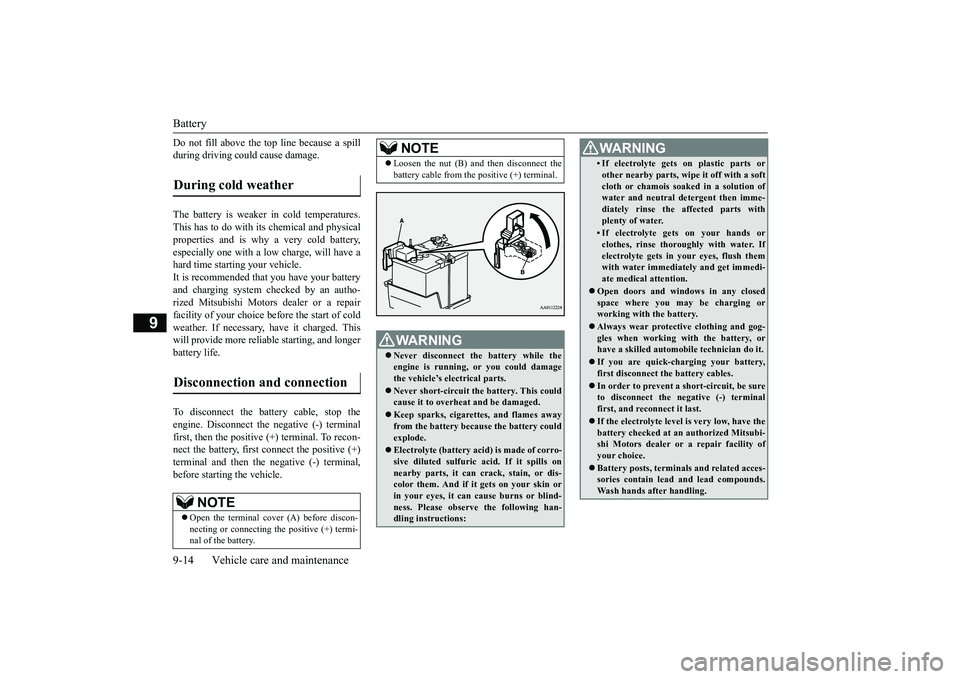
Battery9-14 Vehicle care and maintenance
9
Do not fill above the t
op line because a spill
during driving could cause damage.The battery is weaker in cold temperatures.This has to do with its chemical and physicalproperties and is why a very cold battery,especially one with a low charge, will have ahard time starting your vehicle.It is recommended that you have your batteryand charging system checked by an autho-rized Mitsubishi Motors dealer or a repairfacility of your choice before the start of coldweather. If necessary, have it charged. Thiswill provide more relia
ble starting, and longer
battery life.To disconnect the battery cable, stop theengine. Disconnect the
negative (-) terminal
first, then the positive (+) terminal. To recon-nect the battery, first
connect the positive (+)
terminal and then the negative (-) terminal,before starting the vehicle.During cold weather Disconnection and connection
NOTE
Open the terminal cover (A) before discon-necting or connecting
the positive (+) termi-
nal of the battery.
Loosen the nut (B) and then disconnect thebattery cable from the positive (+) terminal.WA R N I N GNever disconnect the battery while theengine is running, or you could damagethe vehicle’s electrical parts.Never short-circuit the battery. This couldcause it to overheat and be damaged.Keep sparks, cigarettes, and flames awayfrom the battery because the battery couldexplode.Electrolyte (battery acid) is made of corro-sive diluted sulfuric acid. If it spills onnearby parts, it can crack, stain, or dis-color them. And if it gets on your skin orin your eyes, it can cause burns or blind-ness. Please observe the following han-dling instructions:NOTE
• If electrolyte gets on plastic parts orother nearby parts, wipe it off with a softcloth or chamois soak
ed in a solution of
water and neutral detergent then imme-diately rinse the affected parts withplenty of water.• If electrolyte gets on your hands orclothes, rinse thoroughly with water. Ifelectrolyte gets in
your eyes, flush them
with water immediately and get immedi-ate medical attention.
Open doors and wind
ows in any closed
space where you may be charging orworking with the battery.Always wear protective clothing and gog-gles when working with the battery, orhave a skilled automobile technician do it.If you are quick-ch
arging your battery,
first disconnect the battery cables.In order to prevent a
short-circuit, be sure
to disconnect the negative (-) terminalfirst, and reconnect it last.If the electrolyte level
is very low, have the
battery checked at an
authorized Mitsubi-
shi Motors dealer or
a repair facility of
your choice.Battery posts, terminals and related acces-sories contain lead
and lead compounds.
Wash hands after handling.WA R N I N G
BK0249100US.book 14 ページ 2017年5月10日 水曜日 午前8時49分
Page 438 of 441

Alphabetical index
12-3
12
Fuel hoses
......................................
9-23
Fuel selection
...................................
3-2
Tank capacity
.................................
11-7
Fuel Pump Shut-off System
.................
8-16
Fuses
.................................................
9-26
Fusible links
.......................................
9-25
G
General maintenance
...........................
9-24
General vehicle data
............................
11-4
Genuine parts
.......................................
3-7
Glove compartment
...........................
5-239
Glove compartment light
Bulb capacity
.................................
9-33
H
Hazard warning
flasher switch
...........
5-218
Hazard warning lights
.......................
5-202
Head restraints
....................................
4-11
Headlight leveling switch
..................
5-216
Headlights
Bulb capacity
.................................
9-32
Dimmer
.......................................
5-210
Headlight flasher
..........................
5-211
Replacement
.........................
9-34
, 9-35
Switch
.........................................
5-207
Heated steering wheel switch
.............
5-226
High beam indicator
..........................
5-202
High-mounted stop light
Bulb capacity
.................................
9-32
Hill start assist
...................................
5-95
HomeLink® Wireless
Control System
.5-231
Hood lock release me
chanism and safety
catch
...............................................
9-25
Horn switch
......................................
5-227
I
If the vehicle breaks down
.....................
8-2
Ignition switch
...................................
5-63
Important facts to know in
case of an accident
10-4Indicators
....................
5-181
, 5-201
, 5-202
Information screen display
.................
5-182
Inside rearview mirror
.........................
5-57
Inspection and maintena
nce following rough
road operation
..................................
5-91
Instrument cluster
..............................
5-154
Interior lights
....................................
5-236
J
Jack
....................................................
8-5
Storage
............................................
8-5
Jump-starting the engine
.......................
8-2
K
Keyless entry system
....................
5-7
, 5-30
Keys
....................................................
5-3
L
Labeling
.............................................
11-2
Lane Departure Warning System (LDW)
.....
5-134License plate light
Bulb capacity
.................................
9-32
Replacement
...................................
9-39
Liftgate
..............................................
5-38
Link System
.....................................
5-227
Loading information
..............................
6-6
Lubricants
..........................................
11-7
Luggage floor box
.............................
5-240
Luggage hooks
.................................
5-246
M
MIVEC engine
..........................
5-26
, 5-67
Modification of your vehicle
..................
3-5
Multi Around Monitor
.......................
5-144
Multi information display - Type 1
.....
5-155
Multi information display - Type 2
.....
5-173
BK0249100US.book 3 ページ 2017年5月10日 水曜日 午前8時49分